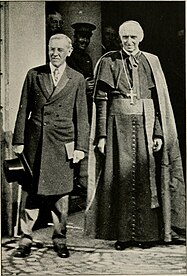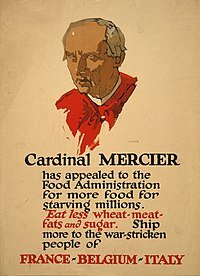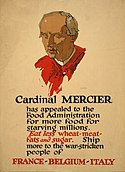Désiré-Joseph Mercier
| Jeho Eminence Désiré-Joseph Mercier | |
|---|---|
| Kardinál Arcibiskup mechelenský primas Belgie | |
 Désiré-Joseph kardinál Mercier | |
| Církev | římskokatolická |
| Provincie | mechelenská |
| Arcidiecéze | mechelenská |
| Sídlo | Mechelen |
| Období služby | 1906-1926 |
| Předchůdce | Pierre-Lambert Goossens |
| Nástupce | Jozef-Ernest van Roey |
| Heslo | „Apostolus Jesu Christi“ „Apoštol Ježíše Krista“ |
| Znak | (c) I, SajoR, CC BY-SA 2.5 |
| Svěcení | |
| Kněžské svěcení | 4. dubna 1874 světitel arcibiskup Giacomo Cattani |
| Biskupské svěcení | 25. března 1906 světitel arcibiskup Antonio Vico 1. spolusvětitel Antoon Stillemans 2. spolusvětitel Gustave-Joseph Waffelaert |
| Kardinálská kreace | 15. dubna 1907 kreoval Pius X. |
| Titul | kardinál ze San Pietro in Vincoli |
| Vykonávané úřady a funkce | |
| Zúčastnil se | konzistoř v dubnu 1907, konkláve 1914, konkláve 1922 |
| Osobní údaje | |
| Datum narození | 21. listopadu 1851 |
| Místo narození | zámek Castegier u Braine-l'Alleud, |
| Datum úmrtí | 23. ledna 1926 |
| Místo úmrtí | Brusel, |
| Národnost | belgická |
| Některá data mohou pocházet z datové položky. | |
Désiré Felicien François Joseph Mercier (21. listopadu 1851, Braine-l'Alleud – 23. ledna 1926, Brusel) byl belgický římskokatolický duchovní, arcibiskup mechelenský, kardinál a akademik. V době první světové války představoval v Belgii hlavní osobnost odporu vůči německým okupantům.[1]
Život
Désiré-Joseph se narodil v roce 1851 v Belgii. Vyučoval na mechelenské katolické univerzitě filozofii a následně se stal tamním rektorem. Papež Pius X. jej jmenoval arcibiskupem mechelenským v roce 1906 a o rok později byl kreován kardinálem.
Během první světové války došlo k okupaci Belgie, proti které kardinál Mercier (podobně jako král Albert I.) aktivně vystupoval, což mu u většiny obyvatelstva vyneslo uznání a společenský respekt.[1][2]
Od roku 1919 spolupracoval se Světovým svazem bratrství. Kardinál Mercier se zasadil o rozšíření svátku Panny Marie prostřednice všech milostí, který v roce 1921 získal církevní povolení pro Belgii, následně i pro další země.[3] Zemřel v Bruselu v lednu 1926.
Filozofické názory
Po encyklice papeže Lva XIII. Aeterni Patris (1879) došlo v Belgii k velkému rozmachu propagandy tomistické filozofie. Podle papežových instrukcí z roku 1882 bylo na Katolické univerzitě v Lovani zavedeno přednášení tomistické filozofie, kterou tu začal vyučovat Désiré-Joseph Mercier. Projevil velkou aktivitu v propagaci a propracování novotomismu. V roce 1894 založil časopis Revue Néoscholastique (později byl nazván Revue philosophique de Louvain).[4]
V souladu s plány Vatikánu vytyčil úkol zdůvodnit tomistickou filozofii na základě moderní vědy. Tvrdil, že propast mezi přírodovědou a scholastikou je pouhé nedorozumění, a vyzýval, aby se odstranila „intelektuální izolace“ katolíků.[5]
Vliv
Désiré-Joseph Mercier měl mnoho žáků, kteří pokračovali v propagaci neoscholastiky (Simon Deploige, Maurice De Wulf, Désiré Nys, Armand Thiéry aj.).[5]
Galerie
- Prezident Woodrow Wilson a kardinál Mercier, 1919
- Kardinál Mercier a prezident Raymond Poincaré
- Plakát s kardinálem Mercierem z první světové války
- Socha kardinála Mericera před bruselskou katedrálou
Odkazy
Reference
V tomto článku byl použit překlad textu z článku Désiré-Joseph Mercier na francouzské Wikipedii.
- ↑ a b Nezlomný národ: Okupace Belgie během první světové války (2) [online]. stoplusjednicka.cz [cit. 2020-05-09]. Dostupné online.
- ↑ Cardinal Mercier in the First World War. Belgium, Germany and the Catholic Church [online]. theo.kuleuven.be [cit. 2020-05-09]. Dostupné online. (anglicky)
- ↑ Panna Maria, Prostřednice všech milostí [online]. jesuit.cz [cit. 2020-05-09]. Dostupné online.
- ↑ Dynnik a Michejev 1963, s. 535.
- ↑ a b Dynnik a Michejev 1963, s. 536.
Literatura
- DYNNIK, M. A.; MICHEJEV, V. I., 1963. Belgie. In: DYNNIK, Michail; JOVČUK, M. T.; MITIN, M. B. Dějiny filosofie. 1. vyd. Praha: SNPL. Svazek 5. Kapitola 15 „Filosofické a sociologické myšlení v Belgii a v Holandsku v epoše imperialismu (konec XIX. a počátek XX. století)”, s. 534–541.
Externí odkazy
 Obrázky, zvuky či videa k tématu Désiré-Joseph Mercier na Wikimedia Commons
Obrázky, zvuky či videa k tématu Désiré-Joseph Mercier na Wikimedia Commons - Désiré-Joseph Mercier na Catholic hiearchy (anglicky)
Média použitá na této stránce
This is the national flag of Belgium, according to the Official Guide to Belgian Protocol. It has a 13:15 aspect ratio, though it is rarely seen in this ratio.
Its colours are defined as Pantone black, Pantone yellow 115, and Pantone red 032; also given as CMYK 0,0,0,100; 0,8.5,79,0; and 0,94,87,0.Autor: Internet Archive Book Images, Licence: No restrictions
Identifier: literarydigesthi10hals (find matches)
Title: The Literary digest history of the world war, compiled from original and contemporary sources: American, British, French, German, and others
Year: 1919 (1910s)
Authors: Halsey, Francis W. (Francis Whiting), 1851-1919, comp
Subjects: World War, 1914-1918
Publisher: New York, London, Funk & Wagnalls Company
Contributing Library: Columbia University Libraries
Digitizing Sponsor: MSN
View Book Page: Book Viewer
About This Book: Catalog Entry
View All Images: All Images From Book
Click here to view book online to see this illustration in context in a browseable online version of this book.
Text Appearing Before Image:
ion in1916, more than made amends for earlier criticism by now ascribingto him rare gifts. From the liberal Daily News, in London, whichsaw in him a supreme master of statecraft, to the Tribuna in Rome,which had to go back to Cavour for his parallel, there came an ad-miring chorus. Extreme ideas prevailed as to the seclusion in whichhe loTed to live. The Paris Rappel compared his solitude to that ofa monk. Others made comparisons with great ecclesiastical states-men of the Middle Ages. German dailies conceded his ability, butinclined ta present him as artful, crafty, and hypocritical. TheBerlin Kreuz-Zeitung deemed him an altogether sinister figure,devious in methods, subtfe in policy, and lacking scruple. He hadnot hesitated, in the opinion of the Frankfurter Zeitung, to play thepart of tool for the British. He was born a trickster, who had suc-ceeded Sir Edward Grey as the worlds arch-demon. The complete revolution that took place in Entente estimates after The Times (New York). 286
Text Appearing After Image:
© INTERNATIONAL FILM SERVICE. N. Y PRESIDENT WILSON AND CARDINAL MERCIER The two are standing at the entrance to the Cardinals house in Malines PERSONAL SKETCHES OF WAR LEADERS 1916 was based on considerations set forth elaborately in the LondonDaily Neics. His ability to lead stinick that journal as amazing.There had been no one in Europe to compare with him since Glad-stone, altho the traits and temperaments of the two were as the polesasunder. Mr. Wilson showed in his acts a comprehension of politicson the scientific side which living statesmen of the European coun-tries had conspicuously lacked. In him, said the Tribuna of Rome,Germans in the Wilhelmstrasse had met their match; they found theynow had a scholarly recluse to overreach. This man of fine phrase,this dealer in terms so spontaneous and unforced that he seemed todo his thinking aloud, this idealist and democrat, could understandan Austria ruled by the Metternich method as easily as he coulddivine a Prussian Junker. No Am
Note About Images
Le cardinal Mercier reçoit le président Poincaré à la basilique de Malines in L'Illustration, n° 3987, 2 août 1919.
World War I Poster. Appeal to Food Administration by Belgian cardinal Désiré-Joseph Mercier (1851-1928). Text : "Cardinal Mercier has appealed to the Food Administration for more food for starving millions. Eat less wheat, meat, fats and sugar. Ship more to the war-stricken people of France, Belgium, Italy."
Autor: VitVit, Licence: CC BY-SA 4.0
Brusel katedrála sv. Michaela a sv. Guduly
(c) I, SajoR, CC BY-SA 2.5
Coat of arms of the belgian cardinal Désiré Félicien-François-Joseph Mercier.
Reference:
Cardinal Mercier à Rome, 1916











